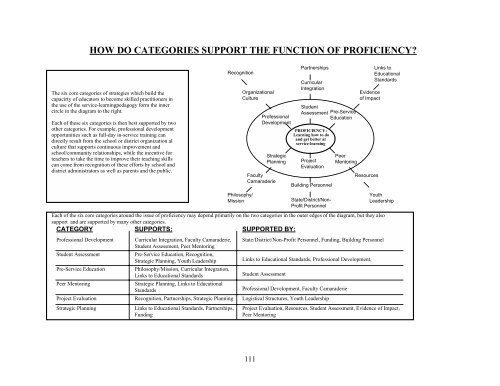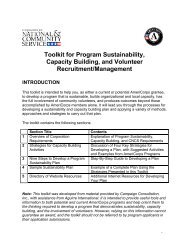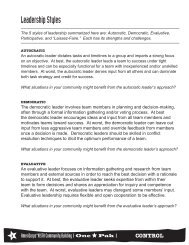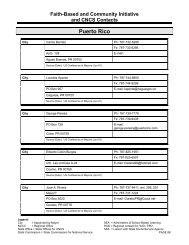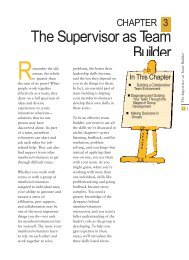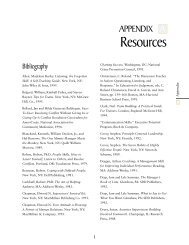MAKE IT LAST FOREVER: THE ... - National Service Resource Center
MAKE IT LAST FOREVER: THE ... - National Service Resource Center
MAKE IT LAST FOREVER: THE ... - National Service Resource Center
Create successful ePaper yourself
Turn your PDF publications into a flip-book with our unique Google optimized e-Paper software.
HOW DO CATEGORIES SUPPORT <strong>THE</strong> FUNCTION OF PROFICIENCY?<br />
The six core categories of strategies which build the<br />
capacirty of educators to become skilled practitioners in<br />
the use of the service-learningpedagogy form the inner<br />
circle in the diagram to the right.<br />
Each of these six categories is then best supported by two<br />
other categories. For example, professional development<br />
opportunities such as full-day in-service training can<br />
directly result from the school or district organization al<br />
culture that supports continuous improvement and<br />
school/community relationships, while the incentive for<br />
teachers to take the time to improve their teaching skills<br />
can come from recognition of these efforts by school and<br />
district administrators as well as parents and the public.<br />
Recognition<br />
Philosophy/<br />
Mission<br />
Organizational<br />
Culture<br />
Professional<br />
Development<br />
Strategic<br />
Planning<br />
Faculty<br />
Camaraderie<br />
Partnerships<br />
Curricular<br />
Integration<br />
Student<br />
Assessment Pre-<strong>Service</strong><br />
Education<br />
PROFICIENCY :<br />
Learning how to do<br />
and get better at<br />
service-learning<br />
Project<br />
Evaluation<br />
Building Personnel<br />
Peer<br />
Mentoring<br />
Evidence<br />
of Impact<br />
<strong>Resource</strong>s<br />
Links to<br />
Educational<br />
Standards<br />
Youth<br />
State/District/Non- Leadership<br />
Profit Personnel<br />
Each of the six core categories around the issue of proficiency may depend primarily on the two categories in the outer edges of the diagram, but they also<br />
support and are supported by many other categories.<br />
CATEGORY SUPPORTS: SUPPORTED BY:<br />
Professional Development Curricular Integration, Faculty Camaraderie,<br />
Student Assessment, Peer Mentoring<br />
State/District/Non-Profit Personnel, Funding, Building Personnel<br />
Student Assessment Pre-<strong>Service</strong> Education, Recognition,<br />
Strategic Planning, Youth Leadership Links to Educational Standards, Professional Development,<br />
Pre-<strong>Service</strong> Education Philosophy/Mission, Curricular Integration,<br />
Links to Educational Standards<br />
Student Assessment<br />
Peer Mentoring Strategic Planning, Links to Educational<br />
Standards<br />
Professional Development, Faculty Camaraderie<br />
Project Evaluation Recognition, Partnerships, Strategic Planning Logistical Structures, Youth Leadership<br />
Strategic Planning Links to Educational Standards, Partnerships,<br />
Funding<br />
Project Evaluation, <strong>Resource</strong>s, Student Assessment, Evidence of Impact,<br />
Peer Mentoring<br />
111


